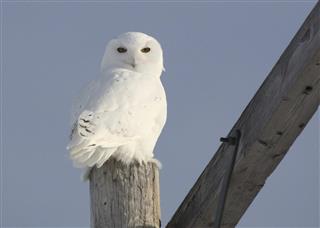
One of the most magnificent creatures of the wild is the snowy owl, also known as the ‘Great White Owl’. This article briefs you about the lifespan of these birds. It also lists down some important facts about them.
Also known as the ‘Great White Owl’, the Snowy Owl is named as ‘Bubo scandiacus’ scientifically. Also, it is reputed to be the heaviest owl in North America. Speaking of the snowy owls habitat, they breed on the Arctic tundra, and are known to remain in their breeding ground year-round. However, they have also shown frequent migratory activities towards regions such as that of Canada, the northern regions of the United States of America, Europe and Asia, as well.
Places that are usually populated by these creatures include those which have sparse vegetation, valley floors, and meadows that are poorly drained. An important influencing factor for the habitat for the bird is the availability of rodents such as lemmings. And based upon this factor, these owls may take up summer residence on open fields, marshes and even beaches.
Snowy Owls Lifespan
This species of owls are known to be among the longest-living owls. On an average, they can live up to 9.5 – 10 years in the wild. And in captivity, their lifespan can be as long as 28 years.
Snowy Owl Facts
- These owls prefer living in hollowed holes, instead of perching in trees in forest areas.
- An average adult can weigh up to 3.5-6.6 lb, and have a wingspan of 49-59 inches. Also, it can grow up to 20-28 inches long.
- The name ‘snowy white owl’ can be regarded to be more appropriate for the males only. They are the ones with a completely neat white look, with a rounded head, and black bill. And this whole appearance is unmistakably complimented by the creatures’ brilliant yellow iris.
- The females on the other hand, are not completely white, and they never become so in their entire lifespan. They tend to have a darker appearance than males, which is marked by dusky spotting. The facial region, the center part of the breast area, and the back of the neck, retain a complete white show. Also, the females have a noticeably larger appearance than the males.
- Juveniles are heavily barred and dark spotted. With time, they grow to become more whiter, with males being completely white, and females retaining their barring and streaking.
- Some males may not be completely white, and may have small flecks of dusky plumage.
- Snowy owls are known for their great hunting skills. Gifted with sharp eyesight, and keen hearing senses, it does not take them long to track out a prey that is hiding, even in thick vegetation or snow cover. Their patient nature makes them more successful.
- As I have mentioned, the main delicacy of these owls are lemmings. In a year, an adult can feast on about 1600 hundred of these rodents. However, also being an opportunistic hunter, they do not stop feeding on rabbits, fish and other birds.
- These owls hunt not only during the night, but in broad daylight as well. They are diurnal, unlike most owl species that are nocturnal.
- During the breeding season, the male snowy owl makes sounds of high decibel – loud and booming. In other seasons, these creatures prefer to be in a relatively silent mode.
- Although snowy owls have a few predators, it is during their nesting season that they have to face threat from arctic foxes, dogs, gray wolves, and other avian predators.
The greatest threat that these beautiful creatures of the Earth face is from human activities, although environmental conditions are also some offenders. One of their cousins, the Laughing Owl was declared extinct in the earlier twentieth century. So given the human intervention, it may not take long even for this species to come under the list of extinct animal species, unless the importance of their place in the ecological pyramid is understood well and respected.






